
1-3 N64 Hardware and System Features
1-3-1 Hardware Features
The CPU is fast (about 100 MIPS) and includes the following on-chip cache memory:

Figure 1-3-1 CPU Cache Memory
N64 doesn't require a special dedicated chip to process graphics and audio as was the case with Super NES. N64 uses software to execute almost all processes.
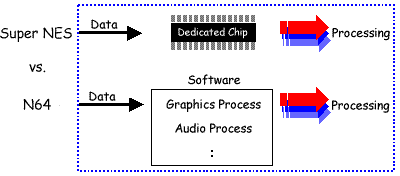 |
Figure 1-3-2 Process are executed by software
The main memory (RDRAM) can be used by the entire system. Programmers are free to divide up the main memory into buffers (frame buffer, audio buffer, Z-buffer, heap, texture buffer, and so on) as appropriate for each game program. It is a unified memory system.
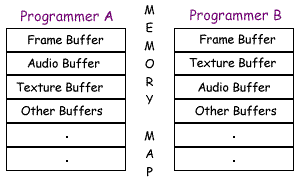
Figure 1-3-3 Unified Memory System
Almost all processes are executed by the CPU and RCP working together.
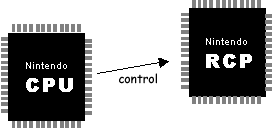 |
Figure 1-3-4 CPU and RCP execute a process in common
The RCP consists of two internal processors the RSP (Reality Signal Processor) and the RDP (Reality Display Processor), I/O Interface, and control logic.
 |
Figure 1-3-5 The configuration of RCP
The RSP and RDP work together to execute GBI (Graphics Binary Interface) commands and render graphics into the frame buffer. The GBI commands are strung together into a specialized command list call the display list.
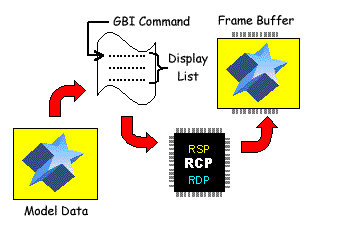 |
Figure 1-3-6 RSP and RDP on the graphics process
The RSP also interprets ABI (Audio Binary Interface) commands and creates linear PCM data using the sampling rate specified by the audio buffer.
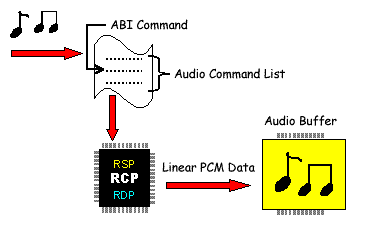 |
Figure 1-3-7 RSP onthe audio process
The RSP interprets GBI and ABI commands using software called microcode.
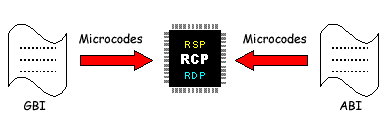 |
Figure 1-3-8 RSP interprets commands by microcode
The image drawn in the frame buffer is transferred to the video DAC (Digital-to-Analog Converter) through DMA (direct memory access). The image becomes the TV image in the video DAC.
 |
Figure 1-3-9 Image Transfered to DAC through DMA
The PCM data placed in the audio buffer is transferred to audio DAC through DMA. The audio becomes sound in the audio DAC.
 |
Figure 1-3-10 The PCM data transfered to the audio DAC by DMA
For faster processing, game programs are not executed on the N64 Game Pak directly. Instead they are loaded into RDRAM first.
Previous N64
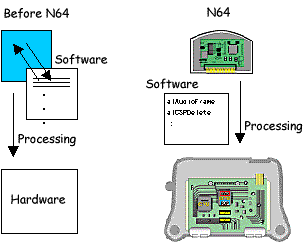 |
Figure 1-3-11 The programs on the Game Pak are loaded on RDRAM
Data coming from the Controller is read by way of the PIF chip as serial data.
Similarly, data in the Controller Pak is also read and written by way of the PIF chip through the Controller as serial data.
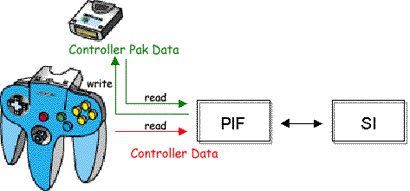 |
Figure 1-3-12 The Data Communication of the Controller
The RDP creates the screen using the Z-buffer (depth buffer) as shown in the following illustration.
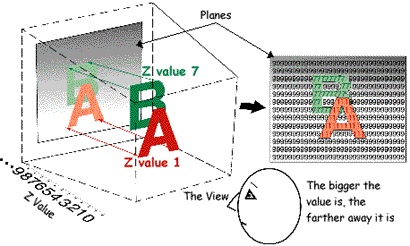 |
Figure 1-3-13 Creating the Screen with the Z-buffer Using RDP
1-3-2System (Software) Features
Game applications are executed in the multi-thread N64 Operating System.
 |
Figure 1-3-14 The application software is executed on OS
Multi-thread programming provides the following advantages:
As a result, there are fewer bugs and debugging time is reduced.
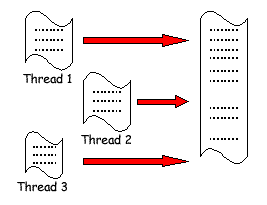 |
Figure 1-3-15 Multi-thread programming
Messages provide information throughput between threads.
 |
Figure 1-3-16 "Message" Provide Information Throughput Between Threads
Threads are executed according to their priority, not their actual position in the program code.
 |
Figure 1-3-17 Software execution is provided by priority of threads
Threads that receive interrupt information messages execute interrupt processing.
 |
Figure 1-3-18 Threads provide the interrupt processing
A high-priority thread called the Scheduler manages all the other threads. The Scheduler thread manages messages for the threads by using tasks or the VI retrace (the vertical synchronizing interrupt).
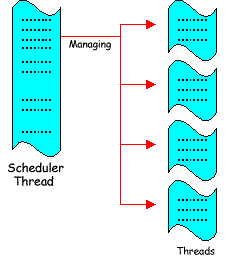 |
Figure 1-3-19 The scheduler provide management of threads
The CPU executes threads comprised of several processing units (function calls,macros, and so on). The RSP in the RCP, on the other hand, executes processing units called tasks.
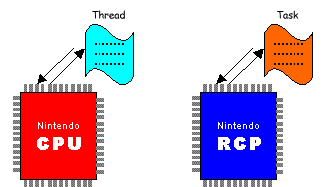 |
Figure 1-3-20 Thread and Task